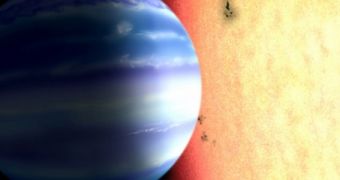A team of astronomers at the California Institute of Technology (Caltech) announces the development of a new investigations technique that could help experts determine how many watery extrasolar planets are around Earth. The method was developed based on data from the W. M. Keck Observatory.
Detecting water molecules or signatures in exoplanetary atmospheres is not something new, but it’s something that is very hard to do with existing techniques. What the team is proposing is a new way to go about conducting this type of studies, one that is easier and can produce more reliable results.
The investigation was led by Caltech professor of cosmochemistry, planetary sciences, and chemistry Geoffrey Blake and his graduate student, first study author Alexandra Lockwood. Details of their work were published in the February 24 issue of the esteemed Astrophysical Journal Letters.
Until now, astronomers could only detect water vapors around other planets if they observed the alien worlds as they were transiting their parent stars. Another scenario where such observations were possible was when the planet was far away enough from its star to allow for direct imaging of its atmosphere.
Caltech scientists basically developed a way for astronomers to identify water vapors – if any are present – around worlds that do not adhere to these strict conditions. Their approach relies on the use of radial velocity measurements and infrared spectroscopy to detect molecules in exoplanetary atmospheres.
The group also used measurements of the exoplanet tau Boo b taken by the Near Infrared Echelle Spectrograph (NIRSPEC) instrument on the Keck Observatory in Hawaii to confirm the presence of water signatures around this planet.
“The readout we get from Keck Observatory’s NIRSPEC is like listening to an orchestra performance; you hear all of the music together, but if you listen carefully, you can pick out a trumpet or a violin or a cello, and you know that those instruments are present,” Lockwood explains.
“The instrument allows you to pick out different pieces; like this wavelength of light means that there is sodium, or this one means that there's water,” she goes on to say, adding that the new technique can also be employed successfully for the measurement of exoplanetary masses.
“They're actually two separate findings, but they're both interesting. When you're doing calculations to look for the atmospheric signature […] you also determine the 3D movement of the star and the planet in the system. And with this 3D movement information, if you also know the mass of the star, you can determine the mass of the planet,” she concludes.

 14 DAY TRIAL //
14 DAY TRIAL //